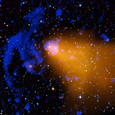Cosmic acceleration could be a sign that the theory of gravity needs to be modified for extremely large distance scales, or that we live in a very large region of space that just happens to have a much lower density than the rest of space. Models based on these explanations have had difficulty in explaining all the data.
Modified GravityModels that seek to explain cosmic acceleration by changing the law of gravity must be consistent with other observations of the amount of helium produced by hydrogen nuclear fusion reactions in the first few minutes, fluctuations in the cosmic microwave background at few hundred thousand years, and the growth of clusters of galaxies billions of years later.
The growth of galaxy clusters is influenced by the expansion rate of the universe, which is controlled by the competing effects of dark matter and dark energy, and by the properties of gravity over large scales. By contrast, observations of supernovas or the large-scale distribution of galaxies, which measure cosmic distances, depend only on the expansion rate of the universe and are not sensitive to the properties of gravity.
Chandra observations of galaxy clusters have been used to test an alternative theory of gravity called called "f(R) gravity." In this theory, the acceleration of the expansion of the universe does not come from an exotic form of energy but from a modification of the gravitational force. Mass estimates of galaxy clusters in the local universe were compared with model predictions for f(R) gravity. Data from geometrical studies, such as supernova work, were also used. Using this comparison between theory and observation, no evidence was found that gravity is different from Einstein's theory on scales larger than 130 million light years. This limit corresponds to a hundred-fold improvement on the bounds of the modified gravitational force's range that can be set without using the cluster data.
In a second study, a comparison was made between X-ray observations of how rapidly galaxy clusters have grown over cosmic time to the predictions of Einstein's theory. Once again, data from geometrical studies such as distances to supernovas and galaxy clusters were incorporated. Nearly complete agreement was seen between observation and theory, arguing against any alternative gravity models with a different rate of growth. In particular a model with 5 dimensions, predicts a slower rate of cluster growth than Einstein's theory because gravity is weakened on large scales as it leaks into an extra dimension.
Inhomogeneous UniverseAs alternative to modifying gravity is to assume that the Milky Way galaxy in which we live is located near the center of a very large, nearly spherical region that has a lower density than the average density of the Universe. It remains to be seen whether such a model can explain all the evidence for cosmic acceleration.
DARK ENERGY AND THE FATE OF THE UNIVERSEIf dark energy is vacuum energy, then the cosmic acceleration will continue and the Universe will expand at an ever-increasing rate. In about 100 billion years, the only galaxies visible will be those nearer than a few million light years.
If dark energy is a scalar field, the possible futures depend on the nature of the scalar field. The expansion could stop and become a collapse, it could expand more or less as in the vacuum energy scenario, or the acceleration could increase without limit, and the Universe would end in a "big rip" that tears apart galaxy clusters, galaxies, stars and eventually, atoms.






